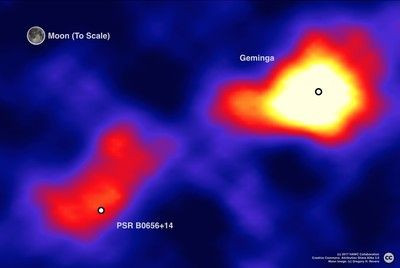Near-Earth Antimatter Not From Nearby Pulsars, Could Have Dark Matter Origins

Even though the total amount of antimatter in the universe today is far less than the amount of matter (if they were the same, the universe wouldn’t exist), antimatter particles in Earth’s vicinity are far more than expected. And of the two types of sources considered likely candidate for this anomaly, one — nearby pulsars — has been ruled out by new observations.
Our planet is constantly bombarded by cosmic rays — a misnomer for high-energy positively charged subatomic particles — and some of those particles are positrons, the antimatter equivalent of electrons. And there are a lot more of them near Earth than current theories predict, a phenomenon that was observed in 2008. Astronomers came up with two theories to explain the aberration. One said it was due to nearby pulsars — rapidly spinning collapsed stars known to emit a large number of particles, including positions. Another ascribed it to unknown processes involving the mysterious dark matter.
An international team of researchers has now disproved the pulsar origin theory. Using data from the High-Altitude Water Cherenkov (HAWC) Gamma-Ray Observatory in Mexico, the scientists found that two nearby pulsars — despite being the right age and at the right distance to be likely candidates for the excess positrons — are actually “surrounded by an extended murky cloud that prevents most positrons from escaping.”
“Since the involvement of close-by pulsars in the generation of high-energy positrons reaching us is so modest, other explanations become more and more likely. The most interesting is the hypothesis about the origin of excess positrons from the decay or annihilation of dark matter,” Sabrina Casanova from the Institute of Nuclear Physics Polish Academy of Sciences said in a statement Thursday.
However, this does not mean that the excess positrons are necessarily originating from some dark matter processes, or that the recent observations are a detection of dark matter.
“Our measurement doesn’t decide the question in favor of dark matter, but any new theory that attempts to explain the excess using pulsars will need to account for what we’ve found,” Jordan Goodman from the University of Maryland and the lead investigator for the HAWC collaboration, said in a university statement Thursday.
The HAWC Observatory is located at an elevation of 13,500 feet, flanking the Sierra Negra volcano inside Pico de Orizaba National Park in the Mexican state of Puebla.

Researchers from the HAWC collaboration published their findings in a paper that appeared online Friday in the journal Science, under the title “Extended gamma-ray sources around pulsars constrain the origin of the positron flux at Earth.”
Following the theories of the Standard Model of physics, all matter in existence should have an equal amount of antimatter, and the two together would annihilate each other, leading to there being nothing. The Standard Model theorizes that both matter and antimatter were created in equal amounts during the Big Bang, and the present-day matter-antimatter asymmetry remains one of the great mysteries of physics.
© Copyright IBTimes 2024. All rights reserved.




















